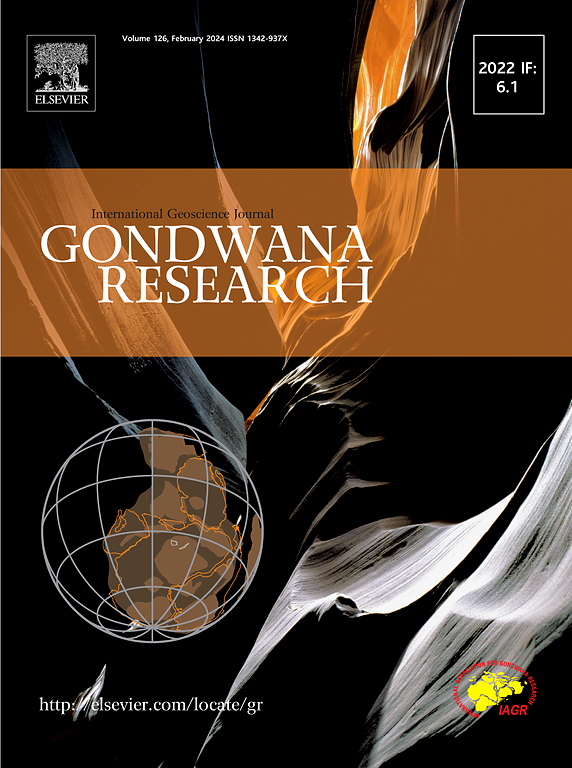东昆仑造山带岩浆弧的基性-超基性根
IF 7.2
1区 地球科学
Q1 GEOSCIENCES, MULTIDISCIPLINARY
引用次数: 0
摘要
岩浆弧是大陆生长的关键因素。本文研究了东昆仑造山带西王沟的镁铁质-超镁铁质套,为了解东昆仑造山带完整的弧形下地壳层序提供了新的思路。通过对整个岩石地球化学、橄榄石、辉石和尖晶石的电子探针微分析、辉石和磷灰石U-Pb同位素的原位微量元素分析,研究了鄂西克拉底火山岩的结晶机制和地壳生长过程。西王沟基性超镁质岩主要由辉长岩、斜辉长岩、辉长岩和角闪辉长岩组成。LA-ICP-MS磷灰石U-Pb年代学表明,辉长岩、斜辉石岩和辉长岩分别在249.6±6.2 Ma、249.7±2.6 Ma和247.8±1.8 Ma形成。角闪石辉长岩年龄略小,为237.6±1.9 Ma。这些岩石由共同的母岩浆结晶而成,并按照Ol + Cpx→Cpx +间隙Pl→Cpx(晚期)+ Pl和含水矿物(Phl和Hb)的顺序进行分步结晶演化。结晶序列、平衡熔体计算及斜辉石质元素组成表明,这些岩石形成于由波长岩向岛弧拉斑岩岩浆过渡阶段。结合已发表的资料,我们提出了一种地壳生长模型,其中基性-超基性岩浆活动主要通过层积体对弧下地壳的生长做出贡献,对中上部地壳的生长贡献较小。本文章由计算机程序翻译,如有差异,请以英文原文为准。

The mafic–ultramafic roots of a magmatic arc from the East Kunlun Orogen, NW China
Magmatic arcs are key contributors to continental growth. Here we investigate a mafic–ultramafic suite from Xiwanggou in the Eastern Kunlun Orogen, offering insights into a complete arc lower crust sequence within the Eastern Kunlun Orogenic Belt (EKOB). We present whole-rock geochemistry, electron probe microanalyses of olivine, pyroxene, and spinel, in-situ trace element analysis of pyroxene and apatite U-Pb isotopic data to gain insights into the crystallization mechanism and the crustal growth process of the EKOB. The Xiwanggou mafic–ultramafic rocks (XMURs) are mainly composed of wehrlite, clinopyroxenite, gabbro, and hornblende gabbro. LA-ICP-MS apatite U-Pb geochronology indicates that the wehrlite, clinopyroxenite, and gabbro formed coevally at 249.6 ± 6.2 Ma, 249.7 ± 2.6 Ma, and 247.8 ± 1.8 Ma, respectively. The hornblende gabbro is slightly younger with an age of 237.6 ± 1.9 Ma. Our data suggest that these rocks crystallized from a common parental magma and evolved through fractional crystallization according to the following sequence: Ol + Cpx → Cpx + interstitial Pl → Cpx (late stage) + Pl, and hydrous minerals (Phl and Hb). The crystallization sequence, calculated equilibrium melts, and elemental composition of clinopyroxenes indicate these rocks were produced during the transition stage from boninitic to island arc tholeiitic (IAT) magma. In conjunction with published data, we propose a crustal growth model for the EKOB in which mafic–ultramafic magmatism contributed mainly to the growth of the arc lower crust by layer cumulates, with a minor contribution to middle-upper crust.
求助全文
通过发布文献求助,成功后即可免费获取论文全文。
去求助
来源期刊

Gondwana Research
地学-地球科学综合
CiteScore
12.90
自引率
6.60%
发文量
298
审稿时长
65 days
期刊介绍:
Gondwana Research (GR) is an International Journal aimed to promote high quality research publications on all topics related to solid Earth, particularly with reference to the origin and evolution of continents, continental assemblies and their resources. GR is an "all earth science" journal with no restrictions on geological time, terrane or theme and covers a wide spectrum of topics in geosciences such as geology, geomorphology, palaeontology, structure, petrology, geochemistry, stable isotopes, geochronology, economic geology, exploration geology, engineering geology, geophysics, and environmental geology among other themes, and provides an appropriate forum to integrate studies from different disciplines and different terrains. In addition to regular articles and thematic issues, the journal invites high profile state-of-the-art reviews on thrust area topics for its column, ''GR FOCUS''. Focus articles include short biographies and photographs of the authors. Short articles (within ten printed pages) for rapid publication reporting important discoveries or innovative models of global interest will be considered under the category ''GR LETTERS''.
 求助内容:
求助内容: 应助结果提醒方式:
应助结果提醒方式:


